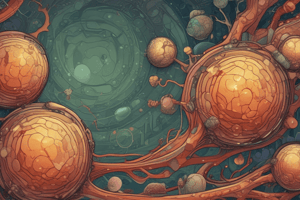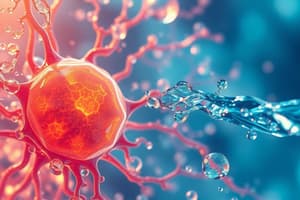Podcast
Questions and Answers
What is the main focus of biochemistry?
What is the main focus of biochemistry?
- Study of the structure of tissues
- Functions of proteins alone
- Classification of organisms
- Chemical processes in living organisms (correct)
Which of the following is NOT considered a macromolecule?
Which of the following is NOT considered a macromolecule?
- Proteins
- Water (correct)
- Carbohydrates
- Lipids
What component accounts for 70% or more of the total cell mass?
What component accounts for 70% or more of the total cell mass?
- Lipids
- Water (correct)
- Nucleic acids
- Proteins
What does the term 'unicellular' refer to?
What does the term 'unicellular' refer to?
Which of the following is NOT a component of cell structure?
Which of the following is NOT a component of cell structure?
What are the two main types of cells?
What are the two main types of cells?
Which of the following characteristics is unique to eukaryotic cells?
Which of the following characteristics is unique to eukaryotic cells?
How do prokaryotic cells reproduce?
How do prokaryotic cells reproduce?
Which of the following statements correctly describes ribosomes in prokaryotic cells?
Which of the following statements correctly describes ribosomes in prokaryotic cells?
What is the primary component of a cell membrane?
What is the primary component of a cell membrane?
In which type of cell would you find organelles like mitochondria and endoplasmic reticulum?
In which type of cell would you find organelles like mitochondria and endoplasmic reticulum?
What type of DNA arrangement do prokaryotic cells have?
What type of DNA arrangement do prokaryotic cells have?
Which of the following is NOT a feature of prokaryotic cells?
Which of the following is NOT a feature of prokaryotic cells?
What characteristic of phospholipids allows them to form a bilayer in the cell membrane?
What characteristic of phospholipids allows them to form a bilayer in the cell membrane?
Which statement accurately describes the arrangement of phospholipids in the cell membrane?
Which statement accurately describes the arrangement of phospholipids in the cell membrane?
What role do cholesterol molecules play in the cell membrane?
What role do cholesterol molecules play in the cell membrane?
What prevents polar or charged substances from easily crossing the phospholipid bilayer?
What prevents polar or charged substances from easily crossing the phospholipid bilayer?
What is the primary function of glycolipids in the cell membrane?
What is the primary function of glycolipids in the cell membrane?
Which of the following describes the tails of phospholipids?
Which of the following describes the tails of phospholipids?
Which type of lipid is specifically absent in plant cell membranes?
Which type of lipid is specifically absent in plant cell membranes?
What describes the initial formation of liposomes in an aqueous environment?
What describes the initial formation of liposomes in an aqueous environment?
What effect do unsaturated fatty acid tails have on membrane fluidity?
What effect do unsaturated fatty acid tails have on membrane fluidity?
How does temperature influence the fluidity of the cell membrane?
How does temperature influence the fluidity of the cell membrane?
What role does cholesterol play in membrane fluidity?
What role does cholesterol play in membrane fluidity?
Which of the following statements about the selective permeability of cell membranes is true?
Which of the following statements about the selective permeability of cell membranes is true?
What defines passive transport across the cell membrane?
What defines passive transport across the cell membrane?
What is the primary function of the receptors and channels found in cell membranes?
What is the primary function of the receptors and channels found in cell membranes?
What type of transport requires energy from ATP to move substances across the membrane?
What type of transport requires energy from ATP to move substances across the membrane?
Which transport mechanism is used for moving large molecules like proteins into the cell?
Which transport mechanism is used for moving large molecules like proteins into the cell?
Which of the following substances must exit the cell as waste?
Which of the following substances must exit the cell as waste?
What is the primary difference in the process of facilitated diffusion compared to simple diffusion?
What is the primary difference in the process of facilitated diffusion compared to simple diffusion?
Which statement correctly describes a concentration gradient?
Which statement correctly describes a concentration gradient?
Which type of molecules primarily undergo simple diffusion through the cell membrane?
Which type of molecules primarily undergo simple diffusion through the cell membrane?
What role do channel proteins play in the process of facilitated diffusion?
What role do channel proteins play in the process of facilitated diffusion?
Which characteristic is true for carrier proteins in facilitated diffusion?
Which characteristic is true for carrier proteins in facilitated diffusion?
Which substance typically diffuses out of cells due to a higher internal concentration?
Which substance typically diffuses out of cells due to a higher internal concentration?
Passive transport is characterized by which of the following?
Passive transport is characterized by which of the following?
Study Notes
Biochemistry
- The study of chemical processes in living organisms.
- It combines biology and chemistry.
- Biochemistry focuses on the structure and interactions of biological macromolecules within cells.
- Biomolecules include carbohydrates, proteins, lipids, and nucleic acids.
- Biochemistry and medicine are closely related.
- Health depends on the balance of biochemical reactions in the body.
- Disease can result from abnormalities in biomolecules and biochemical processes.
Cell Biology
- The branch of biology that studies the structure and functions of cells in living organisms.
- Often referred to as cytology.
- Focuses on cellular processes like respiration, nutrition, cell division, defense mechanisms, and cell death.
- The cell is the fundamental unit of life.
- A tissue is a group of cells with similar structure and function.
- Tissues form organs, and groups of organs work together as an organism.
- Organisms can be unicellular (single-celled) or multicellular (multiple cells).
Composition of Cells
- Cells consist of micromolecules, water, inorganic ions, and carbon-containing molecules.
- Water is the primary component, accounting for 70% or more of a cell's mass.
- Cells have a complex structure comprised of:
- Cell membrane
- Cytoplasm
- Nucleus
- Organelles (e.g., chromosomes, endoplasmic reticulum, ribosomes, mitochondria, lysosomes).
Types of Cells
- Prokaryotic and eukaryotic cells are the main categories.
Prokaryotes
- Always unicellular.
- Very small (0.2-2.0 μm in diameter).
- Lack a nucleus and nuclear membrane; have a nucleoid region.
- Have ribosomes, cell membranes, but lack organelles like the endoplasmic reticulum and mitochondria.
- Single, circular chromosome for DNA.
- Reproduce through binary fission.
- Flagella are smaller in size.
- Examples include bacteria.
Eukaryotes
- Both unicellular and multicellular.
- Much larger than prokaryotes (10-100 μm in diameter).
- Have a true nucleus with a nuclear membrane.
- Have ribosomes, cell membranes, and a variety of organelles.
- Linear DNA in multiple chromosomes.
- Reproduce through mitosis (asexual) and meiosis (sexual).
- Flagella are larger in size.
- Examples include plant and animal cells.
Cell Membrane
- Also known as the plasma membrane.
- Separates the cell's interior from the external environment.
- Composed of a lipid bilayer with embedded proteins and carbohydrates.
Molecular Structure and Composition
- The lipid bilayer is composed of phospholipids, sterols (cholesterol), and glycolipids.
Phospholipids
- Most abundant lipid in the cell membrane.
- Consist of two fatty acid chains (hydrophobic tails) linked to glycerol and a phosphate group (hydrophilic head).
- Amphipathic molecules with both hydrophobic and hydrophilic regions.
- Form a double layer with hydrophilic heads facing outward and hydrophobic tails facing inward, creating a barrier against water and polar substances.
- Form micelles or liposomes when heated in an aqueous solution.
Cholesterol
- Another lipid component of animal cell membranes.
- Selectively dispersed among phospholipids.
- Contributes to membrane rigidity.
- Not found in plant cell membranes.
Glycolipids
- Located on cell membrane surfaces.
- Have a carbohydrate sugar chain attached.
- Involved in cell recognition.
Proteins
- The second major component of plasma membranes.
- Can extend partway into the membrane, cross it completely, or be loosely attached to the inside or outside.
Membrane Fluidity
- Influenced by:
- Fatty acid tails of phospholipids:
- Unsaturated fatty acid chains with double bonds create kinks, increasing fluidity.
- Saturated fatty acid chains with single bonds pack tightly, making a less fluid membrane.
- Temperature:
- Cold temperatures favor tight packing and decrease fluidity.
- Warm temperatures allow for more movement and increase fluidity.
- Cholesterol:
- Holds the membrane in place, preventing excessive separation or compaction.
- Minimizes the effects of temperature on fluidity.
- Fatty acid tails of phospholipids:
Functions of Cell Membranes
- Support cell organelles and maintain cell shape.
- Provide a protective barrier and regulate material passage.
- Exhibit selective permeability, allowing certain molecules to enter or leave while restricting others.
- Contain receptors and channels for specific molecules (ions, nutrients, waste products).
- Regulate the concentration of substances inside the cell (ions, nutrients, waste).
Membrane Transport
- Movement of small molecules occurs through passive diffusion or active transport.
- Transport of large molecules occurs through endocytosis or exocytosis.
Passive Transport
- Movement of substances across the membrane without consuming cellular energy.
- Substances move from a high concentration area to a low concentration area (down the concentration gradient).
- Examples: Simple diffusion and facilitated diffusion.
Simple Diffusion
- Small, lipid-soluble molecules (e.g., oxygen, carbon dioxide) cross the membrane directly.
- Follows the concentration gradient.
Facilitated Diffusion
- Transport of substances that cannot cross the membrane directly (e.g., charged or polar molecules).
- Requires the assistance of membrane transport proteins (carrier proteins and channel proteins).
Carrier Proteins
- Bind specific substances and undergo conformational changes to allow passage across the membrane.
- Each carrier protein is specific to one substance.
Channel Proteins
- Form hydrophilic channels through the membrane, allowing polar molecules to bypass the hydrophobic core.
Active Transport
- Movement of substances across the membrane against their concentration gradient.
- Requires energy from ATP.
Studying That Suits You
Use AI to generate personalized quizzes and flashcards to suit your learning preferences.
Related Documents
Description
Explore the fascinating fields of Biochemistry and Cell Biology. This quiz delves into the chemical processes in living organisms and the fundamental structure and functions of cells. Learn about the crucial roles of biomolecules and cellular processes in maintaining health and life.




